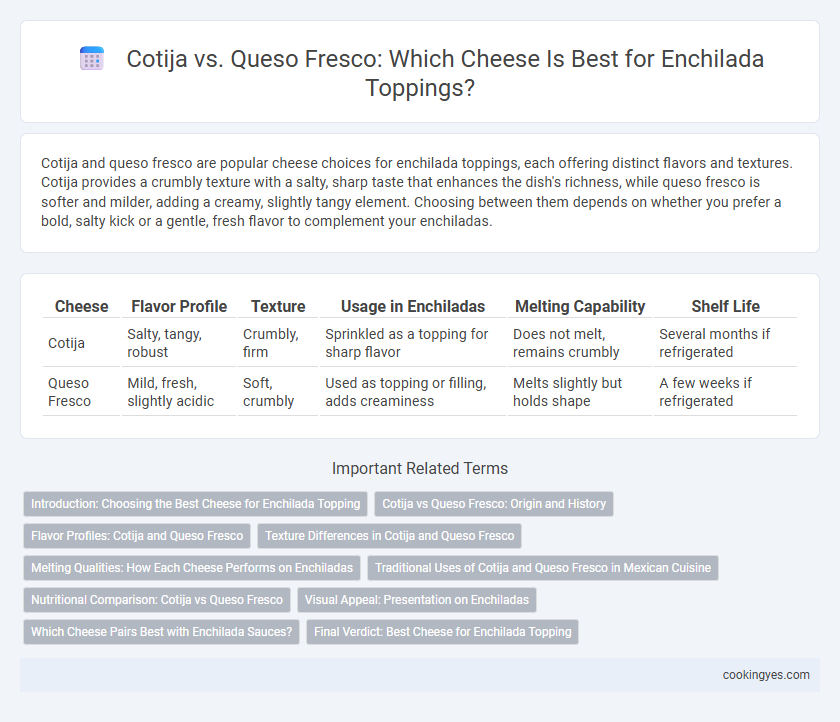Cotija and queso fresco are popular cheese choices for enchilada toppings, each offering distinct flavors and textures. Cotija provides a crumbly texture with a salty, sharp taste that enhances the dish's richness, while queso fresco is softer and milder, adding a creamy, slightly tangy element. Choosing between them depends on whether you prefer a bold, salty kick or a gentle, fresh flavor to complement your enchiladas.
Table of Comparison
| Cheese | Flavor Profile | Texture | Usage in Enchiladas | Melting Capability | Shelf Life |
|---|---|---|---|---|---|
| Cotija | Salty, tangy, robust | Crumbly, firm | Sprinkled as a topping for sharp flavor | Does not melt, remains crumbly | Several months if refrigerated |
| Queso Fresco | Mild, fresh, slightly acidic | Soft, crumbly | Used as topping or filling, adds creaminess | Melts slightly but holds shape | A few weeks if refrigerated |
Introduction: Choosing the Best Cheese for Enchilada Topping
Cotija and queso fresco are popular Mexican cheeses that enhance the flavor and texture of enchiladas with distinct characteristics. Cotija offers a salty, crumbly texture that adds a sharp, intense taste, while queso fresco provides a milder, creamier profile with a subtle tang. Selecting the best cheese depends on whether you prefer a bold, savory punch or a delicate, fresh complement to your enchilada.
Cotija vs Queso Fresco: Origin and History
Cotija cheese, originating from the town of Cotija in Michoacan, Mexico, is a firm, aged cheese known for its salty and crumbly texture, making it ideal for topping enchiladas. Queso fresco, a fresh, soft cheese with a mild and slightly tangy flavor, has roots in traditional Mexican cuisine and is made from cow's milk without aging. Both cheeses reflect distinct regional cheese-making traditions, with Cotija offering a robust, matured taste compared to the creamy, fresh profile of queso fresco.
Flavor Profiles: Cotija and Queso Fresco
Cotija cheese offers a sharp, salty, and crumbly texture that intensifies the rich flavors of enchiladas, providing a bold, savory punch. Queso fresco, with its mild, slightly tangy, and creamy profile, adds a subtle freshness that balances spicy and saucy enchilada varieties. Both cheeses complement enchiladas uniquely, where Cotija enhances robust dishes and Queso fresco suits those needing a delicate, melty finish.
Texture Differences in Cotija and Queso Fresco
Cotija cheese has a crumbly, grainy texture that adds a firm, slightly salty crunch to enchilada toppings, making it ideal for a pronounced texture contrast. Queso fresco, by contrast, boasts a softer, more moist texture that gently melts into the enchilada, providing a creamy and mild finish. The choice between Cotija and queso fresco significantly impacts the overall mouthfeel, with Cotija offering a drier, crumbly bite and queso fresco delivering a tender, melt-in-your-mouth experience.
Melting Qualities: How Each Cheese Performs on Enchiladas
Cotija and queso fresco differ significantly in melting qualities when used as enchilada toppings. Cotija maintains its shape and adds a salty, crumbly texture without melting smooth, while queso fresco softens slightly but does not fully melt, providing a creamy, mild contrast to spicy sauces. For enchiladas, queso fresco offers a more traditional melting experience, whereas Cotija delivers a pronounced, textured finish.
Traditional Uses of Cotija and Queso Fresco in Mexican Cuisine
Cotija cheese, known for its crumbly texture and salty flavor, is traditionally used as a topping to add a bold, savory contrast to enchiladas, enhancing dishes with a robust finish. Queso fresco features a mild, slightly tangy taste and softer consistency, commonly sprinkled over enchiladas to provide a creamy, delicate complement without overpowering the other ingredients. Both cheeses hold distinct roles in Mexican cuisine, with Cotija favored for its intense saltiness and aging, while queso fresco is valued for its fresh, light profile.
Nutritional Comparison: Cotija vs Queso Fresco
Cotija cheese contains higher sodium and fat levels, with approximately 320 mg of sodium and 9 grams of fat per ounce, offering a richer flavor for enchilada toppings. Queso fresco is lower in fat and sodium, averaging 200 mg of sodium and 6 grams of fat per ounce, making it a lighter option with a mild, crumbly texture. Both cheeses provide calcium and protein, but Cotija's higher fat content contributes to a creamier mouthfeel, while queso fresco suits those seeking a less salty, lower-calorie topping.
Visual Appeal: Presentation on Enchiladas
Cotija cheese offers a crumbly texture and bright white color that creates a sharp contrast against the rich red or green enchilada sauce, enhancing the dish's visual appeal. Queso fresco provides a softer, creamier appearance with a slightly off-white hue, giving enchiladas a more subtle and rustic presentation. Choosing Cotija elevates the plating with its defined texture and vibrant look, while queso fresco lends a gentle, understated finish.
Which Cheese Pairs Best with Enchilada Sauces?
Cotija and queso fresco are both popular cheeses for enchilada toppings, but cotija's crumbly texture and salty, tangy flavor pair best with rich, red enchilada sauces, enhancing their boldness. Queso fresco offers a milder, creamy taste that complements green or tomatillo-based sauces, adding a subtle richness without overpowering the fresh, tangy notes. Choosing the cheese depends on balancing the enchilada's sauce intensity and desired texture for optimal flavor harmony.
Final Verdict: Best Cheese for Enchilada Topping
Cotija cheese offers a salty, crumbly texture that enhances enchiladas with a bold, savory flavor ideal for those seeking a robust topping. Queso fresco provides a milder, creamier option that melts slightly, delivering a subtle tang perfect for balancing spicy fillings. The best cheese for enchilada topping ultimately depends on preference: choose Cotija for a punch of flavor and texture, or queso fresco for a gentle, creamy complement.
Cotija vs queso fresco for enchilada topping Infographic

 cookingyes.com
cookingyes.com